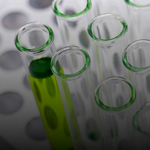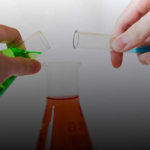Section 1
Preview this deck
Genotype vs Phenotype
Front
Active users
0
All-time users
0
Favorites
0
Last updated
4 years ago
Date created
Mar 1, 2020
Cards (72)
Section 1
(50 cards)
Genotype vs Phenotype
Genotype is the genetic makeup; what can be passed on to your children Phenotype is the physical appearance; what is seen in you right now; how you look
adaptation
inherited trait that is selected for over time because it allows organisms to better survive in their environment
Evolution
Is change in organisms over time
Endoplasmic Reticulum
a system of membranes that is found in a cell's cytoplasm and that assists in the production, processing, and transport of proteins and in the production of lipids; folded transport system for the cell
Producer
organism that obtains its energy from abiotic sources such as sunlight or inorganic chemicals
Artificial Selection
process by which humans modify a species by breeding it for certain traits
Theory
proposed explanation for a wide variety of observations and experimental results
pathogen
agent that causes disease
homologous structures
body part that is similar in structure on different organisms but performs different structures
Gametes
reproductive cells, have only half the number of chromosomes as body cells; in humans, the egg or sperm
fossils
trace of an organism from the past
Darwin's Theory of Natural Selection
1. More offspring are born into a population that can survive.2. These offspring all contain variations 3. These offspring must compete for natural resources 4. The organisms with the best variations will survive and reproduce. (Survival of the fittest)5. Over time, descent (the ancestors will be different from offspring) with modification will occur.
parasitism
ecological relationship in wich one organism benefits y harming the other
descent with modification
The other meaning of evolution referred to structural change in a species that took place over time
Haploid
(genetics) an organism or cell having only one complete set of chromosomes; n - where n is the number of chromosomes
Survival of the fittest
evolutionary theory as a way of describing the mechanism of natural selection. The biological concept of fitness is defined as reproductive success.
Chargaff's Rule
equal amounts of adenine bonds with thymine and equal amount of guanine bonds with cytosine
Mitochondria
Powerhouse of the cell, produces energy (ATP) from oxygen and sugar(Cellular respiration); respiration takes place here
Homologous structures
Are structures that derive from the same body part but may have different forms, i.e. bird wing, bat wing, human arm
Evolution
change in a species over time
Genes
sequence of DNA that codes for a protein and thus determines a trait
host cell
an animal or plant on or in which a parasite or commensal organism lives. a living cell in which a virus multiplies
antibiotics
chemical that kills or slows the growth of bacteria
abiotic factor
nonliving factor in an ecosystem ,such as moisture,air,water,minerals
ecosystem
collection of organisms and nonliving things , such as climate , soil, water, rocks, in an area
biodiversity
variety of life in an area. Biodiversity is a measure of the number and types of organisms that live in an ecosystem
Alleles
different forms of a gene
Chromosomes
threadlike structures made of DNA molecules that contain the genes
Diploid
cell with two of each kind of chromosome; is said to contain a diploid, or 2n, number of chromosomes;2n-where n is the number of chromosomes
habitat
combined biotic and abiotic factors found in the area where an organism lives
ecology
study of interactions among living things and their surroundings
DNA
deoxyribonucleic acid, the material that contains the information that determines inherited characteristics; Base pair matching is: Adenine bonds ONLY with Thymine, Thymine bonds ONLY with Adenine, Cytosine bond ONLY with Guanine, Guanine bond ONLY with Cytosine
biotic factors
living things
fitness
measure of an organisms ability to survive and produce offspring relative to other members of a population
Cell Wall
strong layer around the cell membrane in plants, algae, and some bacteria
DNA Replication
The DNA double helix strand separates and becomes a template for a new and identical strand. As the strand separates each A pairs with a T and T pairs with an A while each C pairs with a G and each G pairs with a C. If the original was ACTCAG then the new strand would be TGAGTC.
vaccine
substance that stimulates an immune response, producing acquired immunity without illness or infection
transpiration
release of vapor through the pores of the skin or the stomata of plant tissue
consumer
organism that obtains its energy and nutrients by eating other organisms
Dominance
an organism with a dominant allele for a particular form of a trait will always exhibit that form of the trait. (ex. Bb ---The big B would be dominant; Allele which masks the presence of a recessive Ex: AA or Aa
species
group of organisms so similar to one another that they can breed and produce fertile offspring
ribosome
organelle that links amino acids together to form proteins
trophic level
level of nourishment in a food chain
extinction
elimination of a species on earth
Meiosis
(genetics) cell division that produces reproductive cells in sexually reproducing organisms; One cell makes two gamete cells 2n -> n
Homozygous
Both alleles are the same (TT) for homozygous dominant or (tt) for homozygous recessive (I used the letter T for an example only. This could be any letter)
community
collection of all of the different populations that live in one area
Heterozygous
Alleles are different (Tt)
virus
infectious particle made only of a strand of either DNA or RNA surrounded by a protein coat
DNA vs RNA
DNA, sugar is deoxyribose, two strands, base - thymine RNA, sugar is ribose, one strand, base - uracil, only molecule to enter or leave the nucleus
Section 2
(22 cards)



